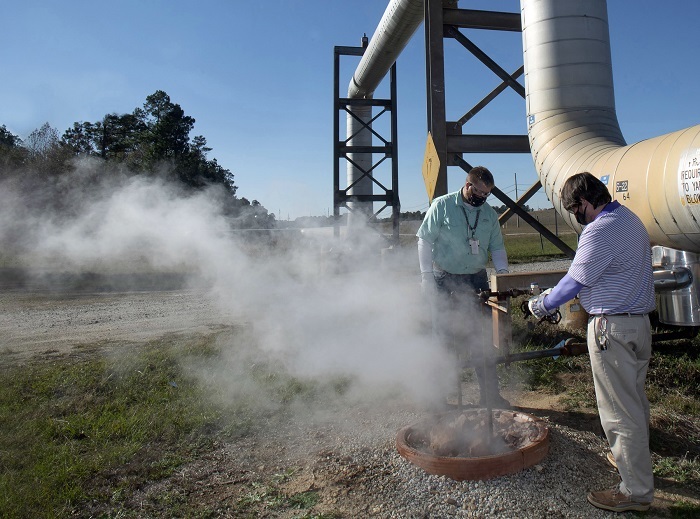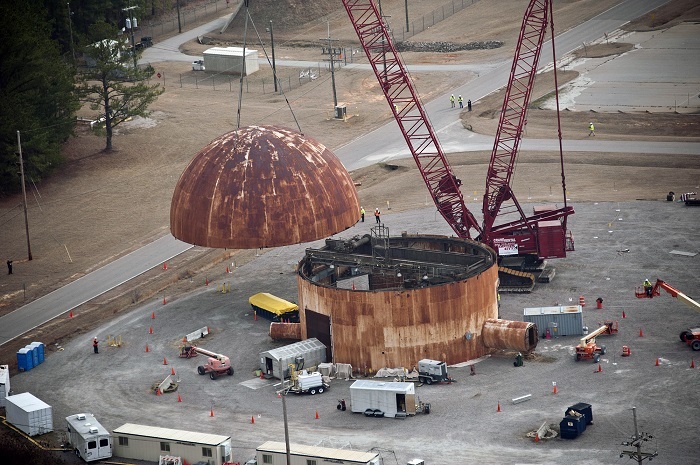 Pictured with this year’s Family Fun Safety Calendar are Jordan Seltzer, left, and Mary Janik with the CH2M HILL BWXT West Valley records management division.
WEST VALLEY, N.Y. – It’s a new year, and EM and its cleanup contractor at the West Valley Demonstration Project (WVDP) have created a new calendar to raise safety awareness among site workers and their families.
The Family Fun Safety Calendar features drawings by the children of WVDP employees depicting general safety practices.
“At the West Valley Demonstration Project, it is understood that safety must be something that is not just remembered, but put into practice every day and in everything we do,” EM WVDP Safety and Site Programs Leader Jennifer Dundas said. “Safety does not start and stop at the worksite. The Family Fun Safety Calendar is designed to engage employees as well as their families and provide a constant reminder on safety awareness.”
The Family Fun Safety Calendar features drawings created by the children of employees from the West Valley Demonstration Project.
Created in-house by employees, the calendars include monthly safety topics that can be discussed at work briefings, meetings, and other occasions. The calendars are distributed to stakeholders and subcontractors to CH2M HILL BWXT West Valley (CHBWV).
“This approach creates safety awareness across the site in a unique way,” said Ken Whitham, CHBWV vice president of environmental, safety, health, and quality. “The calendar allowed us to promote safety onsite as well as at home; and the children’s drawings make them a ‘got-to-have’ item.”
-Contributor: Joseph Pillittere
 Brad Clark, Savannah River Nuclear Solutions (SRNS) operations support specialist, left, and Andrew Ellsworth, SRNS maintenance coordinator, inspect a steam trap. The iconic large silver pipes used to distribute steam across the 310-square-mile Savannah River Site are pictured behind the two employees.
AIKEN, S.C. – Large silver pipes that crisscross the Savannah River Site (SRS) and run along many of its roadways may prompt visitors, new employees, and others to ask, ‘What are all those huge pipes used for?’
Andrew Ellsworth, maintenance coordinator with Savannah River Nuclear Solutions (SRNS), the site’s management and operations contractor, provided a response:
“Steam is generated and distributed across the site through 10 miles of insulated pipe for a wide variety of purposes. Most of the pipes are largely left over from when SRS was built in the 1950s,” he said.
In the site’s early years, using coal to produce steam was an extremely cost-efficient way to heat facilities and provide an effective source of energy for operations, Ellsworth said.
“With stricter Environmental Protection Agency emission standards and aging plant conditions, replacing the coal-fired plants with state-of-the-art biomass steam plants was the best option to continue this service,” he said. “With the new plants in service, our steam generation and distribution systems are now in excellent condition.”
Biomass plants burn excess wood from the logging industry and other sources to heat huge boilers, which create a vast volume of steam to export for site operations. The biomass process produces lower environmental emissions, lessens energy consumption, and decreases operating and maintenance costs, while maintaining compliance with federal clean air and water laws.
Among the five biomass plants at SRS, the first was built in 2008 in an area of the 310-square-mile site near the Savannah River National Laboratory and several administrative facilities. That biomass plant replaced one of the original coal-fired steam plants built at SRS.
SRNS is responsible for the maintenance and operation of one of the five plants. The rest are operated by DOE contractor Ameresco Federal Solutions.
The largest biomass plant at SRS uses a portion of the steam produced to propel a turbine, which can generate up to 20 megawatts of electricity, meeting approximately 30% of the site’s electrical needs. The electricity generated by the plant reduces the amount of power SRNS is required to purchase from an offsite utility.
That plant exports an average of 50,000 pounds of steam per hour — enough to generate heat for 1,350 2,000-square-foot homes for a day.
To ensure a continuous supply of water for steam production, approximately 800 gallons of water per minute are delivered to Ameresco’s primary facility from the Savannah River.
“Some things last the test of time,” said Ellsworth. “The SRS steam generation and distribution system is certainly one of them.”
Workers recently completed a major steam maintenance outage, which included over 175 maintenance tasks just on the steam lines. Steam users took advantage of this outage to perform repairs on their systems to ensure long-term efficient operation.
“Our engineers, operations, and maintenance teams work together to ensure the system continually operates at peak efficiency,” Ellsworth added.
-Contributor: DT Townsend
 In past years, EM used in situ decommissioning for the U Canyon at the Hanford Site; two facilities at the Idaho National Laboratory Site; and the P and R reactors and Heavy Water Components Test Reactor, pictured here, at the Savannah River Site.
EM joined other government organizations and stakeholders from the United States, the United Kingdom, and Canada to discuss different types of in situ decommissioning (ISD) and “ISD-like” remediation and decommissioning strategies, and to better define how these approaches relate to one another, to relevant regulations, and to international frameworks.
The virtual workshop included more than 40 representatives from DOE and:
- Policy organizations, including U.K. Nuclear Decommissioning Authority, and Atomic Energy of Canada Ltd.;
- Federal regulators, including the U.S. Environmental Protection Agency, U.K. Environment Agency, and Canadian Nuclear Safety Commission; and
- State and local regulators, including the Tennessee Department of Environment and Conservation and the South Carolina Department of Health and Environmental Compliance.
“The workshop reinforces the close collaborative relationship with the U.K. and Canada and our commitment to the longstanding alliance among our countries in the field of environmental management,” said Betsy Forinash, director of EM’s Office of Infrastructure Management and Disposition Policy.
Representative from the three countries met to develop a shared understanding of what ISD means in different contexts and how it has been, and is proposed to be, safely implemented.
The term ISD has historically been equated with the International Atomic Energy Agency’s (IAEA) term “entombment,” which in IAEA’s safety requirements and guides is considered an approach to decommissioning that is to be used only in “exceptional circumstances.”
However, the term ISD is used colloquially by different countries to describe a range of acceptable and protective decommissioning end states.
Workshop participants also shared details about previous and potential ISD projects to establish a better appreciation of how these projects are developed to ensure the final decommissioning end state is safe, both now and in the future.
“The shared experience across our programs shows that ISD can be both practical and protective and is a legitimate option to be considered for legacy sites and facilities. Building understanding in open dialogue with stakeholders and regulators is key to successful implementation,” Forinash said.
PADUCAH, Ky. – At a time when community leaders work to address the challenges of social and racial injustice in their communities, the message that Dr. Martin Luther King, Jr. brought to the nation more than 60 years ago continues to be relevant today.
To honor King’s life and legacy, Four Rivers Nuclear Partnership (FRNP) sponsored and presented student awards in the NAACP Fredericka Hargrove Essay and Poster Contest in a virtual event on Jan. 18.
FRNP is the Paducah Site deactivation and remediation contractor for EM’s Portsmouth/Paducah Project Office.
 |
|
Four Rivers Nuclear Partnership Program Manager Myrna Redfield participates in a NAACP virtual award presentation to announce winners of this year’s Fredericka Hargrove Essay and Poster Contest. |
The virtual competition was open to students grades K-12. Students were asked to write an essay or design a poster with the theme “Good Trouble: Honoring the Life of John Lewis.”
This year’s winners from area schools included: Jaxon Thomas and Aniya James from McNabb Elementary School for grades K-3; Malachi Bailey, Regan McGullion, and Emma Goggins from Clark Elementary School for grades 4-5; Preston Goodyke, Naarah White, and Jada Meadows, seventh graders from Paducah Middle School (PMS); Ryan Bidwell, Erica Wurth, and Maggie Rowton, eighth graders from PMS; and Kate Bidwell, Megan Gruber, and Jasmine Meadows, high school students from Paducah Tilghman.
This is the third consecutive year that FRNP has sponsored this community event.
“Our company is committed to enriching the lives of Paducah students and their families through education and mentorship. We do this through partnerships with organizations, such as the NAACP, and we were honored to participate in this year’s contest and event,” FRNP Program Manager Myrna Redfield said.
|